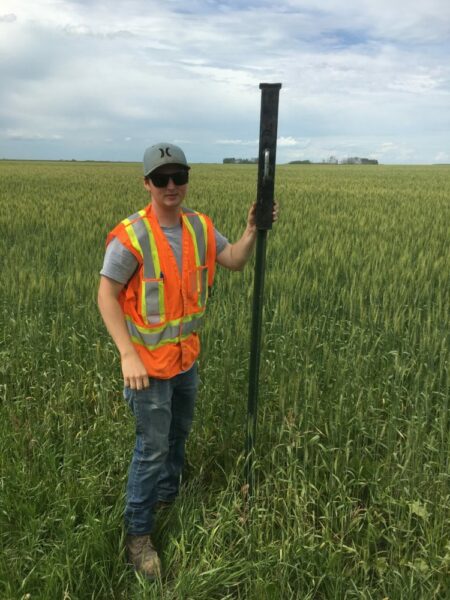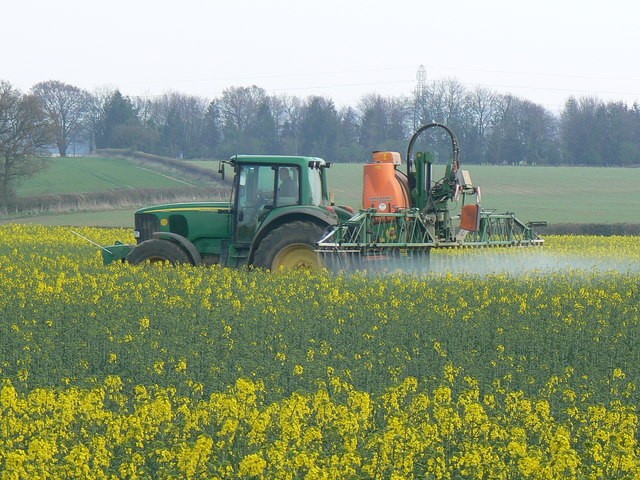By Myles Dupin, University of Saskatchewan Student
Should we scrap the pre-harvest application of glyphosate?
Glyphosate used as a desiccant
Glyphosate is being used as a desiccant on crops like wheat, barley, pulses, and oats (Fleury, 2017). Glyphosate isn’t actually a registered desiccant. Many producers use it as such because it is cheaper and effectively does the same job as registered desiccants. “Glyphosate does not desiccate the crop – it kills it by stopping photosynthesis. Eventual dry-down is 10 to 14 days. A true desiccant actually destroys the cell wall structure, drying out the plant quickly typically in 3 to 5 days” (Smith, 2017). Glyphosate, when not applied at the right time during pre-harvest, creates a higher risk of exceeding maximum residue limits for pesticides (MRLs). If the plant is not mature enough when it is sprayed it will continue taking nutrients into the head of the plant along with small amounts of glyphosate (Smith, 2017).
Public’s perception of glyphosate
For the average consumers learning that their foods may contain residues from a chemical is shocking and frightening to some. Consumers who aren’t apart of the agriculture industry can become persuaded when reading news articles like “Breakfast With a Dose of Roundup”. Headlines such as this catch one’s attention followed by a one-sided opinion on the practices in the ag industry. To most, those headlines are unsettling and cause alarm. The general public may not have intimate knowledge of chemicals or their uses and can be misinformed by activist groups that often only report one side of the topic.
Glyphosate is Safe
The Canadian Food Inspection Agency’s issued a report on over 3000 products they had tested for glyphosate residue. In the report, it was stated that “glyphosate residues above MRLs were found in only 1.3% of samples”(CFIA, 2015-2016). Health Canada assessed this data and found no human health concerns. MRL’s are also based off an average person’s diet where all foods with residues are added up to form a maximum. If a product were to test over the MRL it does not mean that product is toxic to eat.
It’s just business
Some grain millers are feeling pressure to quit accepting grain sprayed with glyphosate as a desiccant. In a statement issued from Grain Millers Inc (2015) “they will no longer accept any oats or oat products which have been treated with glyphosate.” They also said the decision has nothing to do with health and safety concerns, instead its “consumer demands.” Canadian agriculture has changed its practises of using a feed additive ractopamine (Arnason, 2018) in hog production in the past to fit the market place. The switch may be coming whether it’s proven to be safe or not. The market power of consumers is high in this industry which makes producers price takers. Consumers have the luxury of being able to change the market place and are willing to pay more if that is what they want. It will be up to the producers to adopt the new trend and give consumers what they want.
Make the Switch
Instead of possibly being regulated and forced into change, the ag industry can be proactive and no longer accept grain sprayed with glyphosate as a pre-harvest applicant. Chemical residues are a fairly new topic being brought up in the media discussion. A study was done in California where the idea of having residue that is testable in your urine is daunting for consumers. With new technologies being able to test in the parts per billion, it is far better than it was before and is increasingly harder to find an absolute zero when testing for it. “This wouldn’t stop activists from railing against what they view as an evil cancer-causing poison, but it would go a long way to addressing the issue of glyphosate residues in food” (Hursh, 2018). For many consumers, any amounts of residues from a chemical in their food is too much.
Arnason, Robert. (August 2018).”Day of Reckoning Coming for Pre-harvest Glyphosate?” The Western Producer. https://www.producer.com/2018/08/day-of-reckoning-coming-for-pre-harvest-glyphosate/.
CFIA. (2015-2016). “Safe Guarding with Science: Glyphosate Testing in 2015-2016.” http://static.producer.com/wp-content/uploads/2017/04/CFIA_ACIA-9123346-v1-FSSD-FSSS-Glyphosate-Final-Report-15-16_0184101.pdf#_ga=1.196489061.892407858.1492107204
Fleury, Donna. (2016). “Harvest Management Tools – Desiccants and Pre-Harvest Herbicides for Pulses.” https://saskpulse.com/files/general/160805_Harvest_Aid_Products_for_Pulses.pdf
Grain Millers Inc. (2018). “Glyphosate and Oats.” https://www.grainmillers.com/glyphosate-policy/
Hursh, Kevin. (September 2018). “It’s Time to Curtail Pre-harvest Glyphosate.” The Western Producer. https://www.producer.com/2018/09/its-time-to-curtail-pre-harvest-glyphosate/.
Mills, J. Paul, Kania-korwel, Izabela, Fagan, John, et al. (2017). “Excretion of the Herbicide Glyphosate in Older Adults Between 1993 and 2016.” https://jamanetwork.com/journals/jama/fullarticle/2658306
Smith, Lyndsey. (April 2017). “Is Glyphosate the Next Honeybee?” RealAgriculture.com, www.realagriculture.com/2017/04/is-glyphosate-the-next-honeybee/.
Temkin, Alexis. (2018). “Breakfast with a dose of Roundup?” https://www.ewg.org/childrenshealth/glyphosateincereal/
Watson, Elaine. (September 2018). “Glyphosate Residue Free Inquiries Surge as ‘clean Food’ Movement Gathers pace.” Foodnavigator-usa.com. https://www.foodnavigator-usa.com/Article/2018/09/26/Glyphosate-Residue-Free-inquiries-surge-as-clean-food-movement-gathers-pace.
White, Ed. (2018) “Glyphosate Residues Threaten Oats.” https://www.producer.com/2018/09/glyphosate-residues-threaten-oats/

Myles Dupin
My name is Myles Dupin. I have nearly wrapped up my third year pursuing an Agribusiness degree, with a minor in field crop production. I was born and raised on a farm just outside Melfort in the northeast of Saskatchewan. After graduating I plant to move back to my hometown where I will continue to farm as well as work in the Ag Industry.


Myles, you appear to mean well. some of your points might go over well with honest consumers. But you must remember that those doing the fear mongering. that got all this started are not honest or even close to being decent folks. They will take any concession as an admission of guilt and that the science was wrong. they will intensify their attacks. Appeasement, however well intentioned doesn’t work in a war with an evil enemy. Make no mistake. that is what this is. read some of the junk posted by usrtk, ewg, pollan or their ilk. Listen to the lies told by the “”expert witnesses”” and their attorneys in one of the trials. These people must be defeated.
Myles, analytical technology has gone way beyond parts per billion. A friend of mine is an analytical chemist in the Ag Canada lab in Calgary. His main machine is sensitive to 4 parts per femtogram, that is 14 zeros to right of the decimal point. My question is, just because a product can be found, parts per million, billion or femto, what significance is that finding from a toxicological stand point. Most of the press that we see is mainly for the purpose of scare tactics (my opinion).
Pingback: Are agronomy students getting the necessary information on the use of ag chemicals? - SAIFood
Pingback: Are agronomy students getting the necessary information on the use of ag chemicals? – Technology
Pingback: Are agronomy students getting the necessary information on the use of ag chemicals? – Agriculture